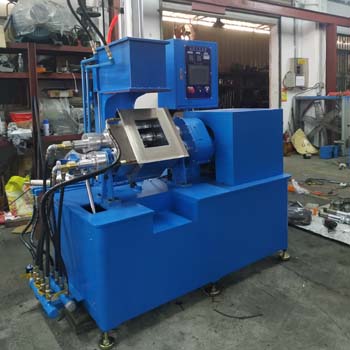Whether it is an experiment in the fields of chemistry, biology or physics, the lab dispersion kneader play very important role in the mixing ,dispersing and stirring of material.
When working with high-viscosity rubber materials—such as FKM, EPDM, or high-filled silicone—the standard configuration of lab dispersion kneader may not be sufficient. These materials require higher torque, better temperature control, and precise rotor design ,so that ensure uniform dispersion and prevent overloading.
Since the lab dispersion kneader can mix various substances evenly, therefore, it ensure the accuracy and repeatability of the experimental results.
Espercially ,for laboratory use ,different laboratories ,they rely on specific types of lab kneader internal mixers ,so that meet their unique needs. When choosing a laboratory dispersion kneader mixer, you may consider many factors such as sample characteristics, mixing volume, mixing speed and accuracy, as well as cleaning and maintenance should be considered comprehensively.
Thus , chose a suitable laboratory mixer can greatly improve the efficiency of the experiment
Here ,in this blog ,let us tell you how to customize a lab dispersion kneader for effective high-viscosity rubber processing.
1. Select a High-Torque Motor and Gearbox
As high-viscosity materials require more force to shear and mix. So when you want to choose a suitable dispersion kneader ,it is very crucial to consider several factors ,such as
* Increased torque rating (typically over 40 Nm for a 3–5L model)
* A reduction gearbox with strong output stability
* Inverter-controlled motor for adjustable speed and better torque at low RPMs
Tip: Always ensure the motor and gearbox are oversized by 20–30% to handle peak loads.
2. Use Special Rotor Designs
Since the type of rotor affects both shear and flow:
* Sigma or Spiral rotors: Ideal for rubber materials, enhancing both mixing and kneading action
* Nitrided or hard chrome coating: Prevents wear from abrasive fillers like carbon black or silica
3. Optimize Temperature Control
High-viscosity rubber can generate excessive heat. To maintain thermal stability:
* Install efficient jacketed chambers for water or oil circulation
* Use dual-zone temperature control (rotor and chamber)
* Integrate digital temperature controllers (PID or PLC) for precise feedback
4. Reinforce Sealing System
Rubber materials can leak or gum up the system if not sealed properly, thus you need to consider two factors, for example , use double-lip mechanical seals with adjustable packing ,and also you need to consider vacuum-compatible seals for degassing volatile components
5. Enable Vacuum Mixing if Possible
In order for better dispersion and de-airing , if possible ,try to equip the lab dispersion kneader with a vacuum pump system ,as vacuum kneader can ensure the mixing chamber vacuum-tight, with reinforced lids and gaskets
6. Control System Customization
Tailor the control system based on laboratory or production requirements:
* PLC with touchscreen HMI: Allows recipe setting, torque monitoring, and real-time temperature control
* Data logging interface: For R&D applications and batch traceability
Therefore ,in conclusion, chose a standard lab dispersion kneader may not deliver the performance needed for high-viscosity rubber materials. By upgrading the torque capacity, customizing rotor design, which enhance thermal control, and integrating intelligent systems, you can significantly improve processing efficiency, compound quality, and lab productivity.
Are you considering tailore Lab Kneader now?
Talk with our experts now , At Simptek , we design and build lab dispersion kneaders tailored for the most demanding materials. Contact us for a free consultation or quote.







